- A Few of My Most-Used Tools & Notions for “Invisible” Machine Appliqué
 by Beth Ann(Updated April 2024) With new sessions of the Modern Rose, The Magic of Invisible Machine Appliqué, Create Your Own Quilted Landscape, and the Celtic Blessings True Lovers Knot Invisible Machine Appliqué classes coming up in my online shop, I thought it might be a good time to share a few of my most-used (and most asked-about) tools and notions. These are all tools that I’ve used for years and have stood the test of time. I hope you’ll find this short list helpful! These are all affiliate links to the exact products I purchased for my own use. Using an… Read more: A Few of My Most-Used Tools & Notions for “Invisible” Machine Appliqué
by Beth Ann(Updated April 2024) With new sessions of the Modern Rose, The Magic of Invisible Machine Appliqué, Create Your Own Quilted Landscape, and the Celtic Blessings True Lovers Knot Invisible Machine Appliqué classes coming up in my online shop, I thought it might be a good time to share a few of my most-used (and most asked-about) tools and notions. These are all tools that I’ve used for years and have stood the test of time. I hope you’ll find this short list helpful! These are all affiliate links to the exact products I purchased for my own use. Using an… Read more: A Few of My Most-Used Tools & Notions for “Invisible” Machine Appliqué - Endings and Beginnings – A Personal Note
 by Beth Ann“New beginnings are often disguised as painful endings.” This quote, usually attributed to Lao Tzu, but perhaps written by someone else entirely, nonetheless speaks to me – especially given what is happening in my life right now. Journal Quilt – Tree of Life. Journal Quilting is one of the ways I process my life experiences and share my journey with others. © Beth Ann Williams The Covid-19 pandemic has pushed the whole world into new territory, and I am no exception. It has been scary and difficult, but it has also offered me new opportunities. I started my career as… Read more: Endings and Beginnings – A Personal Note
by Beth Ann“New beginnings are often disguised as painful endings.” This quote, usually attributed to Lao Tzu, but perhaps written by someone else entirely, nonetheless speaks to me – especially given what is happening in my life right now. Journal Quilt – Tree of Life. Journal Quilting is one of the ways I process my life experiences and share my journey with others. © Beth Ann Williams The Covid-19 pandemic has pushed the whole world into new territory, and I am no exception. It has been scary and difficult, but it has also offered me new opportunities. I started my career as… Read more: Endings and Beginnings – A Personal Note - Celtic Quilt to Celtic Pillow – Sewing Machine or Serger
 by Beth Ann2025 UPDATE: My Celtic patterns can now be found in my online shop. The Celtic True Lovers’ Knot has been appliquéd, quilted, and trimmed, and is now ready for the binding. This would allow you to use the completed piece as a wallhanging. I did consider a wallhanging – I especially liked how it looked when I hung it on point – but I already have several of this design, so I thought it would be fun to turn it into a pillow, instead. This method works not only with this Celtic project, but with any orphan quilt block or… Read more: Celtic Quilt to Celtic Pillow – Sewing Machine or Serger
by Beth Ann2025 UPDATE: My Celtic patterns can now be found in my online shop. The Celtic True Lovers’ Knot has been appliquéd, quilted, and trimmed, and is now ready for the binding. This would allow you to use the completed piece as a wallhanging. I did consider a wallhanging – I especially liked how it looked when I hung it on point – but I already have several of this design, so I thought it would be fun to turn it into a pillow, instead. This method works not only with this Celtic project, but with any orphan quilt block or… Read more: Celtic Quilt to Celtic Pillow – Sewing Machine or Serger - Making a Celtic Quilt – Adding Additional Texture with Machine Quilting
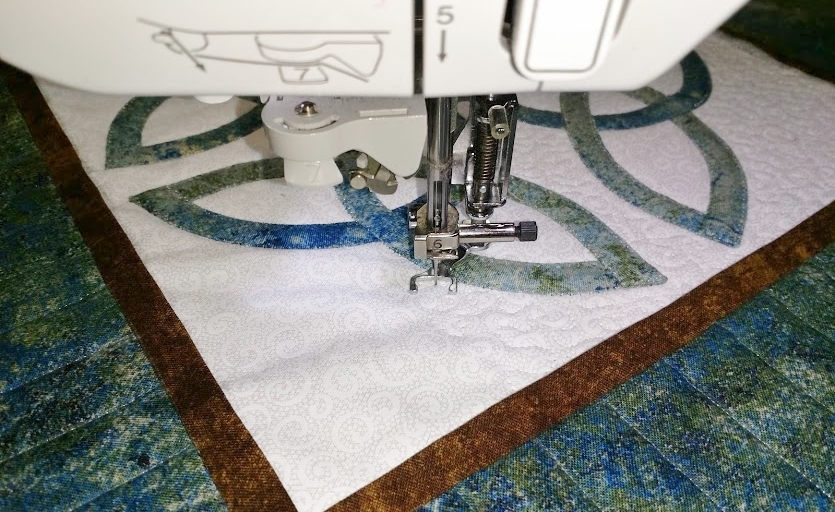 by Beth Ann2025 UPDATE: My Celtic patterns can now be found in my online shop. This is the tenth in a series of posts that will take you step-by-step through the process of creating a Celtic Quilt. The lines that form my Celtic and Celtic-style knotwork designs are formed by cutting bias strips of fabric and sewing them into tubes, which are then fused onto background fabric. For this project, I added the borders, layered the quilt top with batting and backing, and machine appliquéd and quilted the design in one step. Now I’m ready to add a little more texture! Since the design… Read more: Making a Celtic Quilt – Adding Additional Texture with Machine Quilting
by Beth Ann2025 UPDATE: My Celtic patterns can now be found in my online shop. This is the tenth in a series of posts that will take you step-by-step through the process of creating a Celtic Quilt. The lines that form my Celtic and Celtic-style knotwork designs are formed by cutting bias strips of fabric and sewing them into tubes, which are then fused onto background fabric. For this project, I added the borders, layered the quilt top with batting and backing, and machine appliquéd and quilted the design in one step. Now I’m ready to add a little more texture! Since the design… Read more: Making a Celtic Quilt – Adding Additional Texture with Machine Quilting - Making a Celtic Quilt – Top Tips for (Invisible) Machine Appliqué
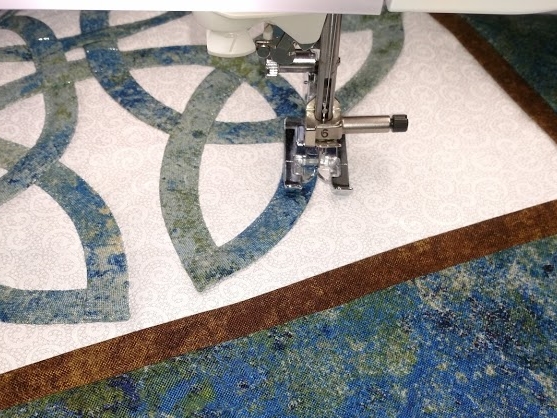 by Beth Ann2025 UPDATE: My Celtic patterns can now be found in my online shop. This is the ninth in a series of posts that will take you step-by-step through the process of creating a Celtic Quilt. The lines that form my Celtic and Celtic-style knotwork designs are formed by cutting bias strips of fabric and sewing them into tubes, which are then fuse-basted onto background fabric. You can choose to appliqué the design (sew everything down), add borders, layer the quilt top with batting and backing, and then quilt by either hand or machine. Or you can choose (as I usually do) to add… Read more: Making a Celtic Quilt – Top Tips for (Invisible) Machine Appliqué
by Beth Ann2025 UPDATE: My Celtic patterns can now be found in my online shop. This is the ninth in a series of posts that will take you step-by-step through the process of creating a Celtic Quilt. The lines that form my Celtic and Celtic-style knotwork designs are formed by cutting bias strips of fabric and sewing them into tubes, which are then fuse-basted onto background fabric. You can choose to appliqué the design (sew everything down), add borders, layer the quilt top with batting and backing, and then quilt by either hand or machine. Or you can choose (as I usually do) to add… Read more: Making a Celtic Quilt – Top Tips for (Invisible) Machine Appliqué - Making a Celtic Quilt – Preparing the Quilt “Sandwich”
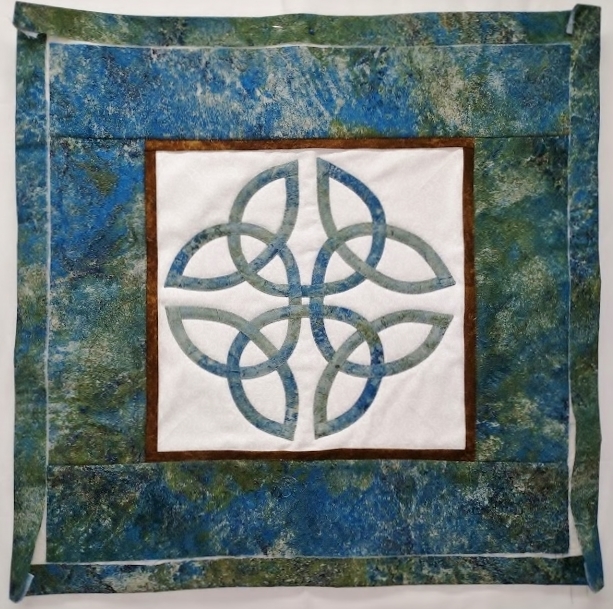 by Beth Ann2025 UPDATE: My Celtic patterns can now be found in my online shop. This is the eighth in a series of posts that will take you step-by-step through the process of creating a Celtic Quilt. The lines that form my Celtic and Celtic-style knotwork designs are formed by cutting bias strips of fabric and sewing them into tubes, which are then fuse-basted onto background fabric. You can choose to appliqué the design (sew everything down), add borders, layer the quilt top with batting and backing, and then quilt by either hand or machine. Or you can choose (as I usually do) to add… Read more: Making a Celtic Quilt – Preparing the Quilt “Sandwich”
by Beth Ann2025 UPDATE: My Celtic patterns can now be found in my online shop. This is the eighth in a series of posts that will take you step-by-step through the process of creating a Celtic Quilt. The lines that form my Celtic and Celtic-style knotwork designs are formed by cutting bias strips of fabric and sewing them into tubes, which are then fuse-basted onto background fabric. You can choose to appliqué the design (sew everything down), add borders, layer the quilt top with batting and backing, and then quilt by either hand or machine. Or you can choose (as I usually do) to add… Read more: Making a Celtic Quilt – Preparing the Quilt “Sandwich” - Making a Celtic Quilt – Adding Borders
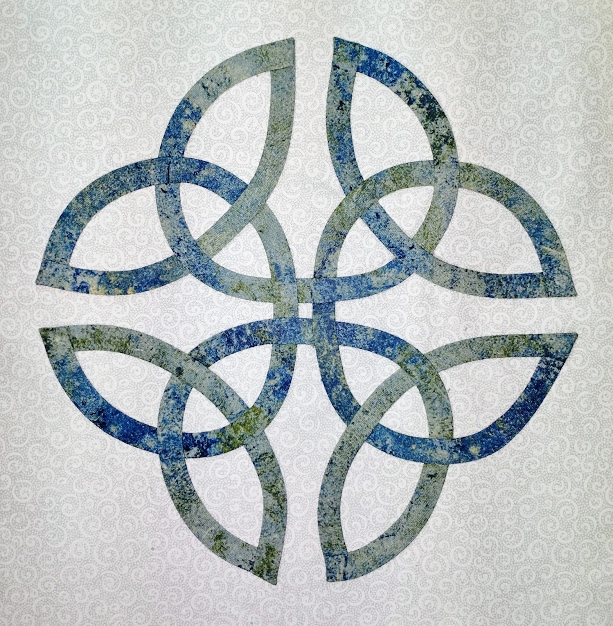 by Beth Ann2025 UPDATE: My Celtic patterns can now be found in my online shop. This is the seventh in a series of posts that will take you step-by-step through the process of creating a Celtic Quilt. The lines that form my Celtic and Celtic-style knotwork designs are formed by cutting bias strips of fabric and sewing them into tubes, which are then fuse-basted onto background fabric. You can choose to appliqué the design (sew everything down), add borders, layer the quilt top with batting and backing, and then quilt by either hand or machine. Or you can choose (as I usually do) to… Read more: Making a Celtic Quilt – Adding Borders
by Beth Ann2025 UPDATE: My Celtic patterns can now be found in my online shop. This is the seventh in a series of posts that will take you step-by-step through the process of creating a Celtic Quilt. The lines that form my Celtic and Celtic-style knotwork designs are formed by cutting bias strips of fabric and sewing them into tubes, which are then fuse-basted onto background fabric. You can choose to appliqué the design (sew everything down), add borders, layer the quilt top with batting and backing, and then quilt by either hand or machine. Or you can choose (as I usually do) to… Read more: Making a Celtic Quilt – Adding Borders - Making a Celtic Quilt – “Basting” the Appliqué Design
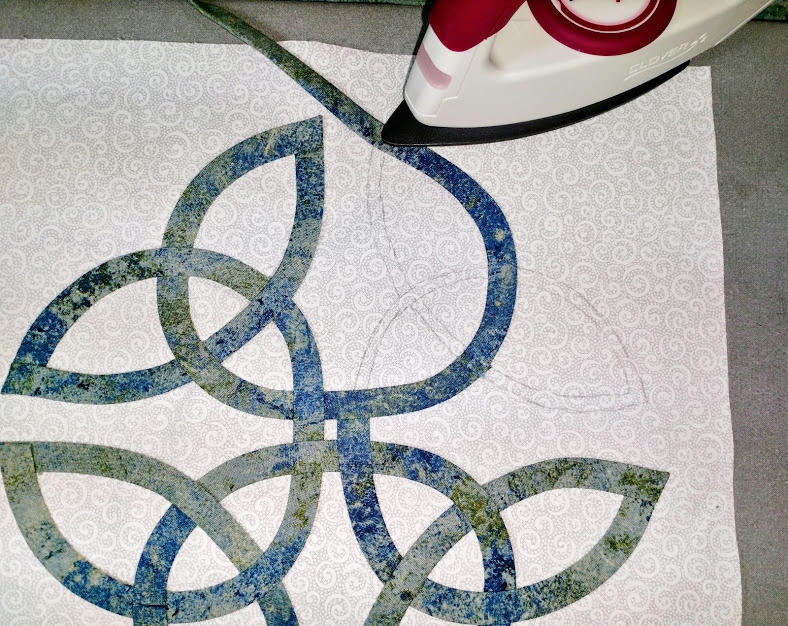 by Beth Ann2025 UPDATE: My Celtic patterns can now be found in my online shop. This is the sixth in a series of posts that will take you step-by-step through the process of creating a Celtic Quilt. The lines that form my Celtic and Celtic-style knotwork designs are formed by cutting bias strips of fabric and sewing them into tubes, which are then fuse-basted onto background fabric. The fabric tubes have been trimmed and pressed, and are ready to go. How do you get them positioned smoothly on the fabric? First of all, I don’t recommend using pins – they will only poke you… Read more: Making a Celtic Quilt – “Basting” the Appliqué Design
by Beth Ann2025 UPDATE: My Celtic patterns can now be found in my online shop. This is the sixth in a series of posts that will take you step-by-step through the process of creating a Celtic Quilt. The lines that form my Celtic and Celtic-style knotwork designs are formed by cutting bias strips of fabric and sewing them into tubes, which are then fuse-basted onto background fabric. The fabric tubes have been trimmed and pressed, and are ready to go. How do you get them positioned smoothly on the fabric? First of all, I don’t recommend using pins – they will only poke you… Read more: Making a Celtic Quilt – “Basting” the Appliqué Design - Making a Celtic Quilt – Pressing the Bias Tubes
 by Beth Ann2025 UPDATE: My Celtic patterns can now be found in my online shop. This is the fifth in a series of posts that will take you step-by-step through the process of creating a Celtic Quilt. The lines that form my Celtic and Celtic-style knotwork designs are formed by cutting bias strips of fabric and sewing them into tubes, which are then fuse-basted and machine appliquéd onto background fabric. The strips have been sewn into tubes, but how do you hide the seam allowance along the side? There are two main ways to deal with this: Either way, you’ll need a 3/8″ wide… Read more: Making a Celtic Quilt – Pressing the Bias Tubes
by Beth Ann2025 UPDATE: My Celtic patterns can now be found in my online shop. This is the fifth in a series of posts that will take you step-by-step through the process of creating a Celtic Quilt. The lines that form my Celtic and Celtic-style knotwork designs are formed by cutting bias strips of fabric and sewing them into tubes, which are then fuse-basted and machine appliquéd onto background fabric. The strips have been sewn into tubes, but how do you hide the seam allowance along the side? There are two main ways to deal with this: Either way, you’ll need a 3/8″ wide… Read more: Making a Celtic Quilt – Pressing the Bias Tubes - Making a Celtic Quilt – Sewing the Bias Strips
 by Beth Ann2025 UPDATE: My Celtic patterns can now be found in my online shop. This is the fourth in a series of posts that will take you step-by-step through the process of creating a Celtic Quilt. The lines that form my Celtic and Celtic-style knotwork designs are formed by cutting bias strips of fabric and sewing them into tubes, which are then machine appliquéd onto background fabric. Your strips are all cut – what next? Now to sew them into tubes… If you cut your strips 1 1/4″ wide, you’ll need to sew them with a SCANT 1/4″ seam. You can use your… Read more: Making a Celtic Quilt – Sewing the Bias Strips
by Beth Ann2025 UPDATE: My Celtic patterns can now be found in my online shop. This is the fourth in a series of posts that will take you step-by-step through the process of creating a Celtic Quilt. The lines that form my Celtic and Celtic-style knotwork designs are formed by cutting bias strips of fabric and sewing them into tubes, which are then machine appliquéd onto background fabric. Your strips are all cut – what next? Now to sew them into tubes… If you cut your strips 1 1/4″ wide, you’ll need to sew them with a SCANT 1/4″ seam. You can use your… Read more: Making a Celtic Quilt – Sewing the Bias Strips - Making a Celtic Quilt – Cutting the Bias Strips
 by Beth Ann2025 UPDATE: My Celtic patterns can now be found in my online shop. This is the third of a series of posts that will take you step-by-step through the process of creating a Celtic Quilt. The lines that form my Celtic and Celtic-style knotwork designs are formed by cutting strips of fabric and sewing them into tubes. The first thing to decide is how wide you want your finished tubes of fabric to be. I’ve seen many beautiful Celtic-style designs created with 1/4″ wide (finished) tubes, but I prefer to use 3/8″ wide (finished) tubes for a couple of reasons: (1) they are easier to… Read more: Making a Celtic Quilt – Cutting the Bias Strips
by Beth Ann2025 UPDATE: My Celtic patterns can now be found in my online shop. This is the third of a series of posts that will take you step-by-step through the process of creating a Celtic Quilt. The lines that form my Celtic and Celtic-style knotwork designs are formed by cutting strips of fabric and sewing them into tubes. The first thing to decide is how wide you want your finished tubes of fabric to be. I’ve seen many beautiful Celtic-style designs created with 1/4″ wide (finished) tubes, but I prefer to use 3/8″ wide (finished) tubes for a couple of reasons: (1) they are easier to… Read more: Making a Celtic Quilt – Cutting the Bias Strips - Making a Celtic Quilt – Fine-Tuning the Design & Preparing the Background
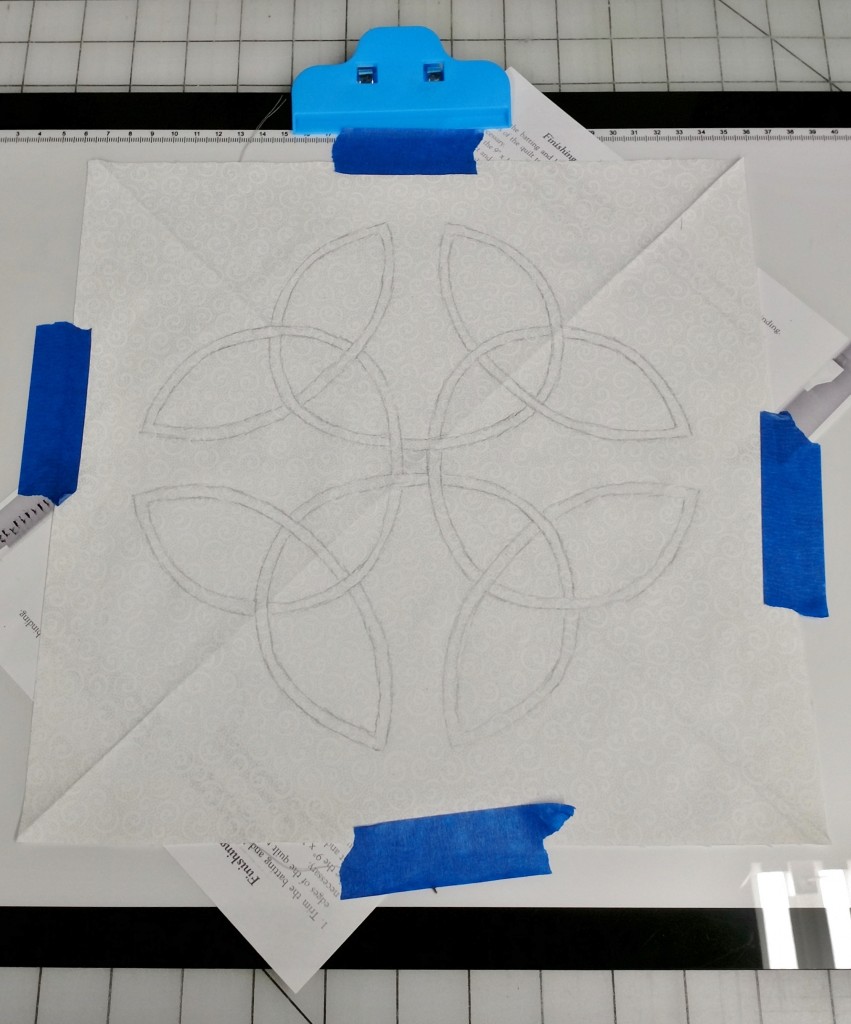 by Beth Ann2025 UPDATE: My Celtic patterns can now be found in my online shop. This is the second of a series of posts that will take you step-by-step through the process of creating a Celtic Quilt. One of the first things you need to do is finalize your design choice and fine-tune it, if necessary. If you are using an original design or using a design from a source other than my book, you need to be sure it will be easily adaptable for sewing. Here are the elements common to historic Celtic knotwork and interlace – rules that I follow when… Read more: Making a Celtic Quilt – Fine-Tuning the Design & Preparing the Background
by Beth Ann2025 UPDATE: My Celtic patterns can now be found in my online shop. This is the second of a series of posts that will take you step-by-step through the process of creating a Celtic Quilt. One of the first things you need to do is finalize your design choice and fine-tune it, if necessary. If you are using an original design or using a design from a source other than my book, you need to be sure it will be easily adaptable for sewing. Here are the elements common to historic Celtic knotwork and interlace – rules that I follow when… Read more: Making a Celtic Quilt – Fine-Tuning the Design & Preparing the Background - Making a Celtic Quilt – Selecting Fabrics
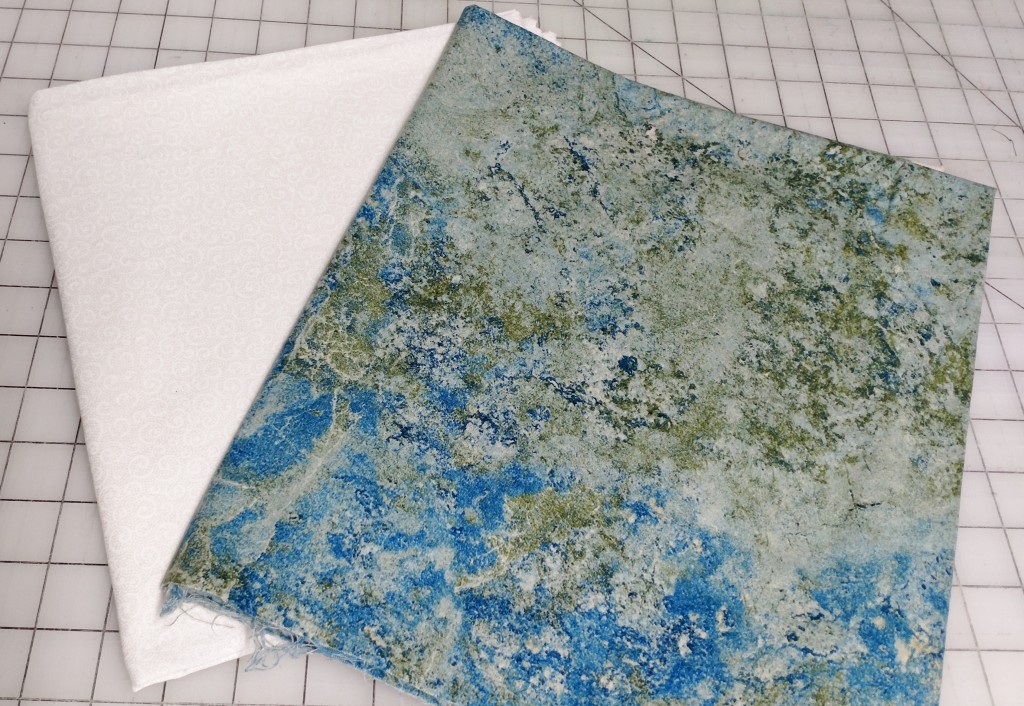 by Beth Ann2025 UPDATE: My Celtic patterns can now be found in my online shop. This is the first of a series of posts that will take you step-by-step through the process of creating a Celtic Quilt. We’ll be creating the True Lover’s Knot, one of the beginner-friendly patterns from my book, Celtic Quilts: A New Look for Ancient Designs (pp. 36-29). Along the way, we’ll explore how to make a 16″ x 16″ machine appliquéd and quilted wall-hanging (start to finish), a quilted pillow, or a quilt block that can be incorporated into a larger quilt. What will you need? Understandably, I… Read more: Making a Celtic Quilt – Selecting Fabrics
by Beth Ann2025 UPDATE: My Celtic patterns can now be found in my online shop. This is the first of a series of posts that will take you step-by-step through the process of creating a Celtic Quilt. We’ll be creating the True Lover’s Knot, one of the beginner-friendly patterns from my book, Celtic Quilts: A New Look for Ancient Designs (pp. 36-29). Along the way, we’ll explore how to make a 16″ x 16″ machine appliquéd and quilted wall-hanging (start to finish), a quilted pillow, or a quilt block that can be incorporated into a larger quilt. What will you need? Understandably, I… Read more: Making a Celtic Quilt – Selecting Fabrics - Journal Quilts with Celtic Knotwork
 by Beth Ann2025 UPDATE: My Celtic patterns can now be found in my online shop. To me, Journal Quilting is a handy shorthand way to describe quilting as a vehicle for personal reflection and expression. Although I impose no size restrictions on myself, the pieces are generally on the smaller side, which better lends itself to a sense of immediacy. I often incorporate 3 dimensional elements, hand beading, hand painting, or other mixed media elements in these works. Free motion quilting adds addition texture. Last month, I shared some of the story behind my book, Celtic Quilts: A New Look for Ancient Designs.… Read more: Journal Quilts with Celtic Knotwork
by Beth Ann2025 UPDATE: My Celtic patterns can now be found in my online shop. To me, Journal Quilting is a handy shorthand way to describe quilting as a vehicle for personal reflection and expression. Although I impose no size restrictions on myself, the pieces are generally on the smaller side, which better lends itself to a sense of immediacy. I often incorporate 3 dimensional elements, hand beading, hand painting, or other mixed media elements in these works. Free motion quilting adds addition texture. Last month, I shared some of the story behind my book, Celtic Quilts: A New Look for Ancient Designs.… Read more: Journal Quilts with Celtic Knotwork - Celtic Quilts – My Journey
 by Beth Ann2025 UPDATE: My Celtic patterns can now be found in my online shop. My first book Celtic Quilts: A New Look for Ancient Designs was published in 2000 by Martingale & Co. The following has been excerpted from a lecture/trunk show that I have shared with quilt guilds, quilt show attendees, and various community groups around the country. I’d like to share with you some of the things in my life that led to my becoming a quiltmaker, and ultimately to the writing of my Celtic book. I’m also going to try to answer some of the questions I’m asked most… Read more: Celtic Quilts – My Journey
by Beth Ann2025 UPDATE: My Celtic patterns can now be found in my online shop. My first book Celtic Quilts: A New Look for Ancient Designs was published in 2000 by Martingale & Co. The following has been excerpted from a lecture/trunk show that I have shared with quilt guilds, quilt show attendees, and various community groups around the country. I’d like to share with you some of the things in my life that led to my becoming a quiltmaker, and ultimately to the writing of my Celtic book. I’m also going to try to answer some of the questions I’m asked most… Read more: Celtic Quilts – My Journey - Machine Quilting FAQ & Top Tips
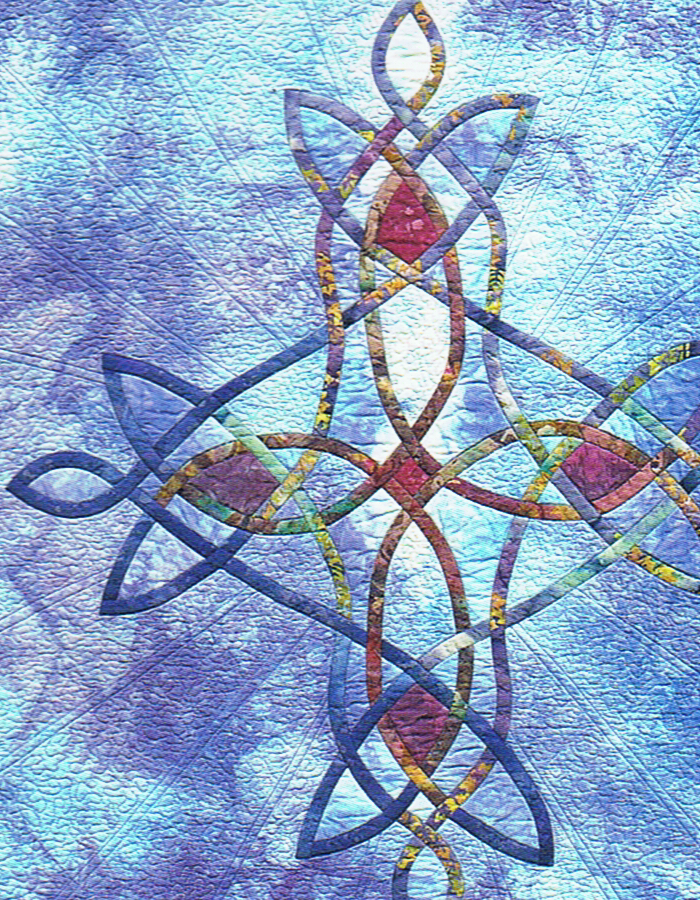 by Beth Ann2025 UPDATE: PDF patterns, online classes and FREEBIES can now be found in my online shop. Here’s another post dealing with FAQ – this time specifically related to using a sewing machine for quilting. For the time being, I’m avoiding the topic of which threads I recommend; we’ll save that for another day! Do you work by hand or by machine? The short answer is both. I almost always use a sewing machine to piece and/or appliqué my quilt tops, both for speed and for durability. When adding the quilting, (the stitching that holds the quilt top, batting, and backing… Read more: Machine Quilting FAQ & Top Tips
by Beth Ann2025 UPDATE: PDF patterns, online classes and FREEBIES can now be found in my online shop. Here’s another post dealing with FAQ – this time specifically related to using a sewing machine for quilting. For the time being, I’m avoiding the topic of which threads I recommend; we’ll save that for another day! Do you work by hand or by machine? The short answer is both. I almost always use a sewing machine to piece and/or appliqué my quilt tops, both for speed and for durability. When adding the quilting, (the stitching that holds the quilt top, batting, and backing… Read more: Machine Quilting FAQ & Top Tips - Celtic Quilts FAQ
 by Beth Ann2025 UPDATE: PDF patterns, online classes and FREEBIES can now be found in my online shop. I no longer have a dedicated FAQ page, so I’m thinking it might be helpful to address frequently asked questions (FAQ) in a series of blog posts. I’ll start with questions related to Celtic-style quiltmaking and my first book, Celtic Quilts: A New Look for Ancient Designs. Are there any rules about what colors or fabrics you should use for Celtic knotwork? If you look at ancient Celtic manuscripts, you see quite a wide variety of colors being used. In some cases, a given… Read more: Celtic Quilts FAQ
by Beth Ann2025 UPDATE: PDF patterns, online classes and FREEBIES can now be found in my online shop. I no longer have a dedicated FAQ page, so I’m thinking it might be helpful to address frequently asked questions (FAQ) in a series of blog posts. I’ll start with questions related to Celtic-style quiltmaking and my first book, Celtic Quilts: A New Look for Ancient Designs. Are there any rules about what colors or fabrics you should use for Celtic knotwork? If you look at ancient Celtic manuscripts, you see quite a wide variety of colors being used. In some cases, a given… Read more: Celtic Quilts FAQ